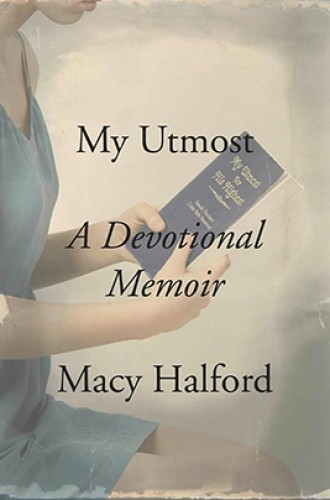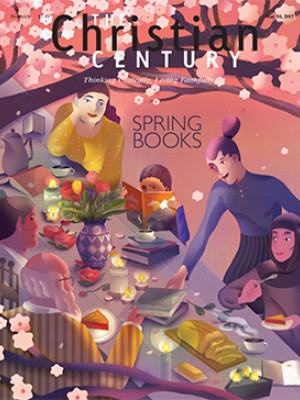Macy Halford’s two worlds
A New Yorker staffer investigates the evangelical book that will not let her go.
Books about books carry more than a smidgen of risk for authors and publishers. Historians of the book, literary scholars, memoirists of the reading life: all face the titanic task of writing about texts that they cannot assume that we, their readers, have read. And publishers must convince us to take an arduous metacognitive leap—reading about reading—as we either read about a book we haven’t read or reach for our credit cards a second time.
I chose the former option when reading Macy Halford’s spiritual memoir, which stitches an evangelical childhood and less-defined young adulthood onto the life and thought of Oswald Chambers, the Scottish author of the classic devotional text My Utmost for His Highest. I considered reading Chambers’s book first, but then realized that I would better represent the interests of Halford’s readers if I stuck with my cluelessness. Halford published her book with Alfred A. Knopf, known for its elegantly literary but decidedly unevangelical works. The Knopf “taste public,” as sociologist Herbert Gans calls people who share preferences for cultural products like books, artwork, and music, isn’t the same taste public that bought millions of copies of Utmost. Halford could not assume that her readers would have any familiarity with the book at the center of her book, let alone any knowledge of the evangelical Christian cosmos in which it has flourished.
Read our latest issue or browse back issues.
Next to the Bible, Chambers’s devotional was the central text of Halford’s 1980s childhood in Texas, as it was for millions of other evangelical Christians in America. The book is entwined with memories of watching her grandmother and mother read it. At first Halford considered the little blue book old-fashioned, “as fusty and tedious as everything else my grandmother liked—the book equivalent of boiled vegetables, potted pansies, needlepoint, PBS, and Chanel No. 5.” But reading Chambers became a daily ritual for her through her youth and into her years at Barnard and her time as a copy editor for the New Yorker.
In the devotional, Halford found a spiritual frame for her days, devotional sustenance in a milieu in which her friends had thrown off any faith they may have once had. She still read Chambers, and she still prayed, instinctively. “The prayer seemed to come of its own accord, as if it were praying itself,” she writes. “It prayed that I might learn to live, as Oswald might put it, in acceptance of the mystery.” Smack-dab in the middle of the coastal elite, Halford remained devoted to the text even as she began to question her Southern Baptist identity, with its “miserliness . . . the way it condemned so much of what I loved—theater, movies, books, music, if those things weren’t Evangelical—and all the people I loved, if those people weren’t saved.”
Then her beloved book showed up in the New York Times. A 2004 op-ed detailed George W. Bush’s habit of beginning his days by reading Utmost and linked Bush’s military campaign in Iraq to certain passages in Chambers’s devotional that valorize obedience in the face of trial. Halford was horrified. How could she love the same book as George Bush and Jerry Falwell did? Were they reading it incorrectly, or was she?
Thus Halford launches into an investigation of the book that will not let her go. She quits her job at the New Yorker to give herself entirely to the task of sketching the history of the book, the biography of its author, and the architecture of evangelical Christianity that housed her childhood. She reads his letters and transcripts of interviews with his daughter, talks to scholars about Chambers and evangelicalism, mulls over the theological relevance of Chambers’s early years as a painter and his later years as an army chaplain, and investigates the role of Oswald’s wife, Biddy, in the shaping of the devotional. She looks at the holiness tradition and “muscular Christianity” that influenced Chambers, and at a variety of themes in his work: devotion to scripture, a personal relationship with Christ, fundamentals of the faith, diligence, and the cross. Each chapter is studded with epigraphs from Chambers’s devotional, giving readers portals into the text.
Throughout the book Halford folds Chambers’s biography and theology into personal narrative, including stories from her childhood church, her moves from Dallas to New York City to Paris, and scenes such as the evening in New York when she goes to a meet-up for Christian women in publishing, where she feels both completely out of place and entirely at home. Halford’s writing demonstrates a deep familiarity with evangelicalism, a roving intelligence about history and theology and art, and a vivid and humorous imagination, and she manages to write with some bewilderment but without disdain of the evangelical world whence she came.
A reading memoirist’s labors are manifold, among them building an adequate measure of suspense and an oscillating pattern between the personal and literary, and even the best writers can founder. At times Halford’s journey seems a bit concocted, as if she struggled to superimpose her own story onto Chambers’s. Or perhaps it’s simply the vagaries of youth that make some of her own decisions ring a bit less dramatic than they would need to be for the mechanism of suspense to fully work. Should she move back to Paris and the arms of the “mountaineer,” as she calls a young man she met there? Or should she return to her mother’s home and to her church? Does her brand of evangelicalism still line up with the Christianity that Chambers embraced, or has it become something else entirely? A young writer sitting on a park bench in New York or Paris ruminating on realism or salvation is not asking bad questions, only somewhat self-conscious ones.
Readers with no intimate connection to Utmost may also be surprised by the depths of Chambers’s biography that Halford’s book plumbs. In that sense, the sections in which Halford serves as docent of contemporary evangelicalism will likely interest readers more than, say, her ruminations on Chambers’s precise understanding of sanctification. The challenge of writing a book about a book dogs even an accomplished author to the very end: Can she make the reader care about her beloved book as much as she does?
The author gestures toward this problem when she sums up the essence of Utmost’s importance to her. “Whenever I thought of it, I thought of my grandmother, and also of my mother,” she writes. “I thought of seeing them sitting high up in their beds at night, reading and praying, powerful in their devotion. The feeling I’d had as a child, watching them, was the feeling I still got each time I opened the book.” She quotes Chambers, who wrote in his diary, “I am ever grateful when I can associate those I love with books that will last as long as my mind will.”
These sentiments open the possibility that any cherished book—any text pressed deep into the lines of memory and heritage and community—could become the warm heart of a reading memoir. The answer to a question that Halford articulates early in the book—“How many books had the power to evolve with a reader over the course of a lifetime, never growing tiresome?”—may be, in fact, “many.”
That Knopf signed Halford to write My Utmost may be a sign that the liberal intelligentsia is not as out of touch with the affections and concerns of Middle America as postelection rhetoric would have us believe. In many ways Herbert Gans’s idea of taste publics illumines Halford’s peregrinations as well as the more mundane map of red state/blue state so often applied these days. During her young life, she has already migrated from one taste public to another. Those of us who have made similar treks usually eschew the books, movies, and music of our previous culture, disguising from our new friends the fact that we ever loved them so. (Amy Grant’s “Father’s Eyes”? Why no, never heard of it.)
But My Utmost boldly introduces Halford’s new taste public to her old one. In it she holds out to her cosmopolitan compatriots a daily devotional, beloved by Baptist grandmothers and a Republican president, and dares them to call it fusty. It’s a feat to be applauded.






